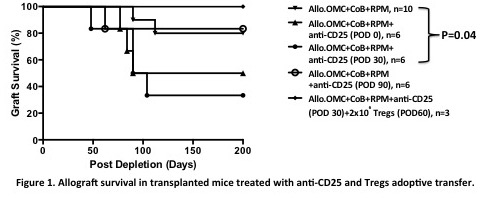Role of Regulatory T Cells in Induction of Tolerance in Mouse Vascularized Osteomyocutaneous Allotransplantation Under Combined Costimulation Blockade.
1Center for Vascularized Composite Allotransplantation, Department of Plastic and Reconstructive Surgery, Chang Gung Memorial Hospital, Linkou, Taoyuan, Taiwan
2Department of Plastic and Reconstructive Surgery, Vascularized Composite Allotransplantation (VCA) Laboratory, Johns Hopkins University School of Medicine, Baltimore, MD.
Meeting: 2016 American Transplant Congress
Abstract number: 87
Keywords: Alloantigens, Co-stimulation, T cells, Tolerance
Session Information
Session Name: Concurrent Session: Allograft Tolerance 1: Animal Models
Session Type: Concurrent Session
Date: Sunday, June 12, 2016
Session Time: 4:30pm-6:00pm
 Presentation Time: 5:18pm-5:30pm
Presentation Time: 5:18pm-5:30pm
Location: Room 306
Background: The role of regulatory T cells (Tregs) in allograft tolerance has been studied using various transplant models, but the mechanism in vascularized composite allotransplantation (VCA) remains unclear. Thus, we investigate the mechanisms of Tregs involved in VCA, and may provide a novel strategy to improve allograft survival.
Methods: Osteomyocutaneous (OMC) allografts from Balb/c were transplanted onto 31 C57BL/6 mice and 1 mg anti-CD154 (POD 0), 0.5 mg CTLA4Ig (POD 2) and 3mg/kg/day for 7 days then every other day for 3 weeks of rapamycin were administered. Transplanted mice were divided into 5 groups: Group 1, No Tregs depletion (n=10); Group 2, injected with 0.5 mg anti-CD25 on POD 0 (n=6); Group 3, injected with anti-CD25 on POD 30 (n=6); Group 4, injected with anti-CD25 on POD 90 (n=6); Group 5, injected with anti-CD25 on POD 30 + 2×106 Tregs isolated from tolerant mice on POD 60 (n=3).
Results: Eight of 10 mice in Group 1 achieved long-term graft survival (>200 days) and showed FoxP3+ Tregs and IL-10 were significantly elevated in the peripheral blood on POD 30 compared to the rejected (p<0.05). FoxP3+ Tregs were also accumulated in the tolerated allograft. Tregs isolated from tolerant animals revealed upregulated expression of GITR+, GATA3+, Tbet+ and stronger suppressive ability than those from rejected animals. Depletion of Tregs affected robust tolerance and rejection was noted in Group 3 (4 of 6, MST=90). But depletion on POD 90 was not. Graft rejection was rescued with adoptive transfer of Tregs from tolerant animals. 
Conclusions: Tregs may play an important role in the induction of VCA tolerance in the early post-transplant phase, and adoptive transfer of Tregs might be an effective therapy to improve allograft survival.
CITATION INFORMATION: Anggelia M, Cheng H.-Y, Wang Y.-L, Chuang W.-Y, Lin C.-H, Brandacher G, Wei F.-C, Lin C.-H. Role of Regulatory T Cells in Induction of Tolerance in Mouse Vascularized Osteomyocutaneous Allotransplantation Under Combined Costimulation Blockade. Am J Transplant. 2016;16 (suppl 3).
To cite this abstract in AMA style:
Anggelia M, Cheng H-Y, Wang Y-L, Chuang W-Y, Lin C-H, Brandacher G, Wei F-C, Lin C-H. Role of Regulatory T Cells in Induction of Tolerance in Mouse Vascularized Osteomyocutaneous Allotransplantation Under Combined Costimulation Blockade. [abstract]. Am J Transplant. 2016; 16 (suppl 3). https://atcmeetingabstracts.com/abstract/role-of-regulatory-t-cells-in-induction-of-tolerance-in-mouse-vascularized-osteomyocutaneous-allotransplantation-under-combined-costimulation-blockade/. Accessed December 29, 2025.« Back to 2016 American Transplant Congress
